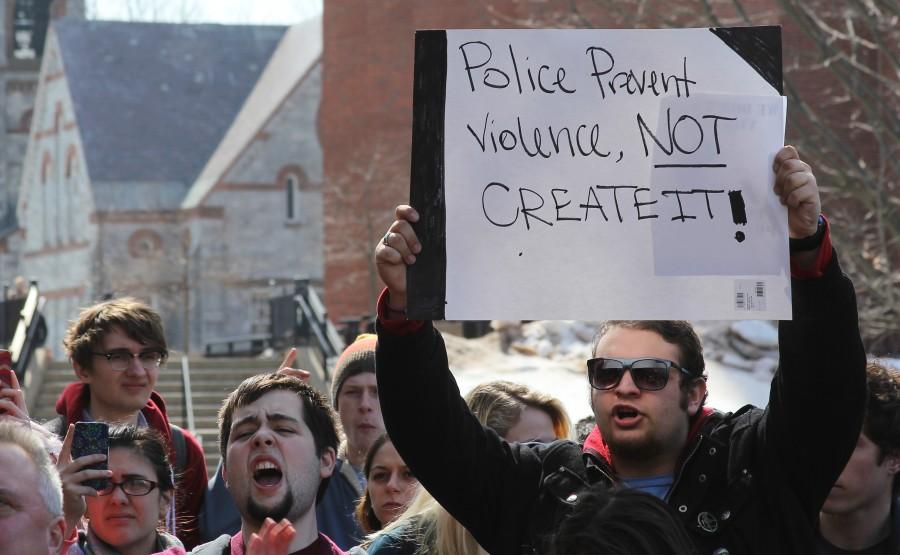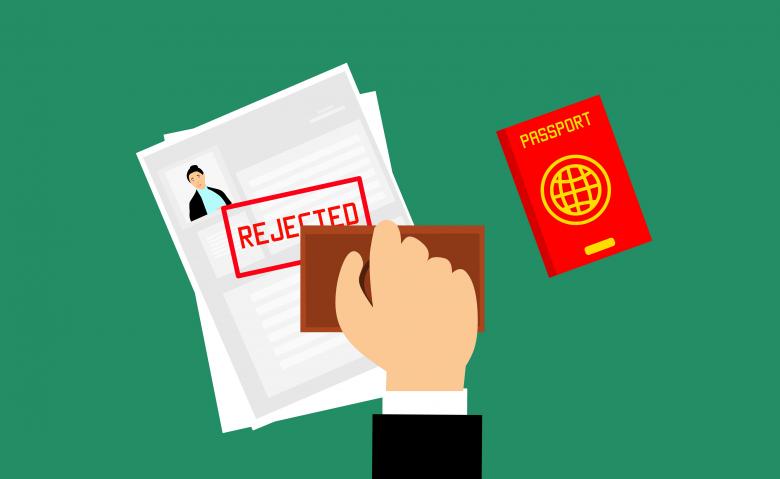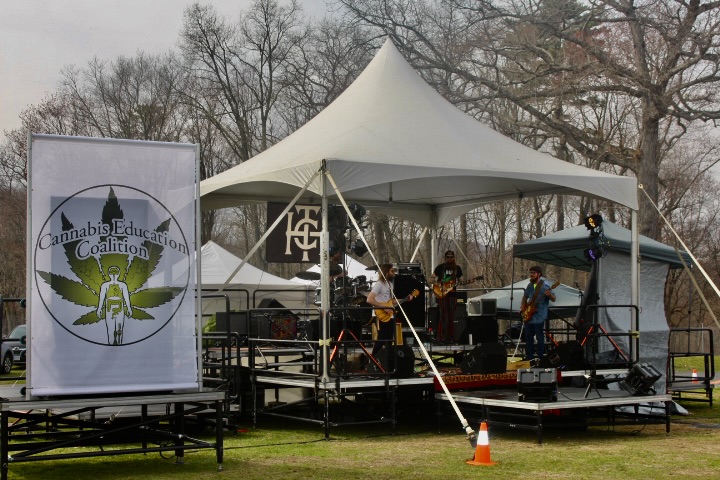)
Video by Elizabeth Geffre
by Rebecca Humphrey
“What do we want? ‘Student rights!’ When do we want them? ‘Now!’”
The chants of passionate students could be heard across the UMass Amherst campus on Tuesday, March 11, as approximately 150 students marched a half mile from the Student Union to the Chancellor’s office in the Whitmore Administration Building. Organized by the Center for Education Policy and Advocacy, the Student Government Association and Divest UMass, the league of students marched in protest of police brutality at this past weekend’s “Blarney Blowout.”
Students were also responding to how they were represented in the aftermath of the event. National news coverage reflected “unruly” student behavior that highlighted four police injuries and more than 70 student arrests, 60 percent of which were later found to be non-UMass students.
“This is us here, defending ourselves, telling the UMass administration that we want to work with them,” said Secretary of Diversity for the SGA, Preston Davis. “We want to be a community as well as have a better relationship with the town of Amherst, but we can’t do that if all of the blame is put on us.”
Protesters came prepared with three demands for the administration and law enforcement. The first demand: an apology from Amherst Police.
“The news channels are making it sound like we are the reason everything happened like we are completely in the wrong and no one is really showing how bad the cops were treating us,” said a UMass sophomore who was arrested on Saturday and now faces expulsion.
Many students were arrested for provoking police while throwing bottles and snowballs but some might raise the question, was the police response necessary?
While a mass of students had gathered at Brandywine that morning, senior legal studies major Brian Bermudez said the Blarney celebration was not out of control until police arrived.
“I remember standing at Brandywine, on the side of the crowd farthest from the police, and it wasn’t a destructive atmosphere,” said Bermudez. “There was a large crowd of people throwing snowballs in the air. That was the worst of it.”
Student stories such as these helped generate the second student demand; a formal investigation into police behavior.
“To react so brutally on a crowd of college kids really sent the police over the top,” said Bermudez. “That should be the embarrassment from the weekend.”
After watching multiple videos on social media, SGA leaders decided to take action.
“I think that Amherst Police Department had a huge part in escalating this event and abusing their power,” said Ellie Miske, Secretary of the Registry on the SGA executive cabinet. “There are videos of students in their own home having pepper balls shot into their house, into their personal property, and that is when it becomes an abuse of power rather than trying to manage an event and keep the community safe.”
Amherst Police Capt. Jennifer Gundersen told The Republican that it was “perhaps one of the worst scenes we have ever had with drunkenness and unruliness.”
Amherst Police declined to comment , but Chief Scott Livingston released a statement earlier in the week stating, “The Amherst Police Department was prepared for increased activity but did not anticipate the dangerous and assaultive behavior and disturbances that would surface from the pre-St. Patrick’s Day celebration. The behavior of many participants of this melee caused the public and first responders to be placed in a very dangerous situation.”
For their last demand, students insisted on a public meeting with Chancellor Subbaswamy.
The Chancellor was unable to attend the protest but Associate Chancellor Susan Pearson spoke on his behalf, agreeing to assist students with the first two of their demands.
“I will urge him to have such a meeting,” said Pearson.
Students have expressed their unhappiness with the Chancellor’s reactions and how the administration spoke to the media.
“I think no one party is to be blamed in this,” said SGA member Miske. “There were students who were acting out and acting irrationally . I think the administration spoke of students in a really negative light after the fact instead of representing us.”
The previous week, an email was sent out to students stating that “‘Blarney Blowout’ is not sanctioned by the University…Students found in violation of the University Code of Student Conduct face the following possible consequences…”
Consequences included: fines, marks on academic records and suspension or expulsion.
The Sunday after Blarney Blowout, the Chancellor posted a press release on the news office website, and emailed it out to UMass students expressing his disappointment.
“I think it reflects badly of the University,” said Pearson. “The media unfortunately like to report these kinds of stories.”
SGA members insisted that students were not given a chance to contribute to a discussion that should have involved the community as a whole.
“I think that it is important to sit down with students and talk about how we could have these events without having these embarrassing events that go to the media and are all over the internet nationally,” said Miske. “It is an embarrassment to the school, and our administration should be working with the students to find out how this can be handled in a safe, healthy way.”
Town residents also expressed their displeasure with the Blarney aftermath, some taking to local media outlets and social media to express their opinion. In response to Tuesday’s protest, town member Nancy Sardeson tweeted at the Amherst Wire Twitter account,
“ @AmherstWire How about an apology to the residents of Amherst for the mess made of our town and for endangering our public safety.”
Although the SGA did not address the impact of Blarney on the town of Amherst, Miske said that residents need to be engaged in finding solutions, because it’s part of living in a college town.
“Blarney Blowout was started by the town and by the bars [of Amherst] and I think if the community wants to benefit from students being here economically and from the energy that is here because it is a college town, then they should also be willing to support these events in a safe way,” said Miske.
Davis said that events like these need to be in a controlled space that is safe for people.
“Yes, get rid of the destructive students,” he said. “We are not condoning violence on our behalf. I don’t think that was in defense, I think it was because people were drunk and for whatever reason had negative attitudes toward the police but that doesn’t give them the right to strip us of our human rights and treat us like we are criminals.”
At the end of the protest, the SGA set up three potential public meeting times with the Chancellor, for either the March 26, or 27th of March, or the 1st of April.
“Our goal, at its root, is to end that kind of behavior but we need the help of students,” said Blaguszewski. “Ultimately it is you the students who need to speak among yourselves and take ownership of the actions. We want to be part of the discussion and the dialogue but there needs to be a community effort. Ultimately people decide what they are willing to do and you know they need to take responsibility and our job is to educate and connect and build the community and encourage students to do the right thing and if they don’t do the right thing, discipline them.”
These are results from an unscientific web survey.
Rebecca Humphrey can be reached via email at [email protected]







